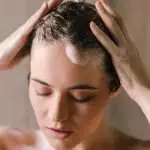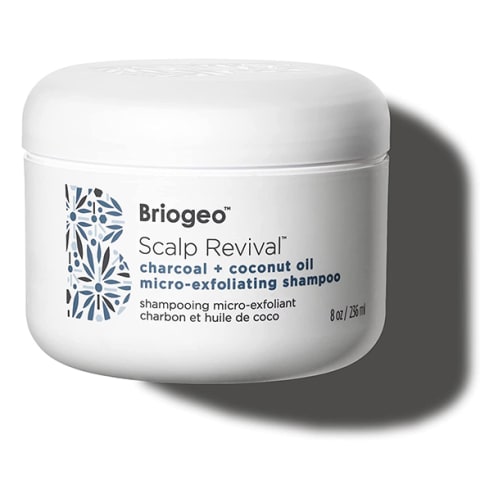
Our editors have independently chosen the products listed on this page. If you purchase something mentioned in this article, we may earn a small commission.
December 11, 2021 — 11:02 AM
Every once in a while, the social media masses will discover a beauty product or category and treat it like it’s bright and shiny and new. But of course, when you go to chat with the experts about the trend, they’ll be the first to tell you: This has been a not-so-secret pro tip for years. This was the case with Instagram contouring (makeup artists have been contouring their celebrity clients for decades upon decades) or even rice water rinses (a tradition that has an ancient history). And it’s now the case with at-home toning shampoos.
Purple shampoos have made a big wave lately, resulting in loads of hacks, questions, and questionable hacks. But as any hairstylist or colorist will tell you, color-correcting pigments have been a professional trick for practically as long as people have been coloring their hair in salons. However, they’ve gained more mainstream popularity—as well as more at-home product offerings have become more widely accessible—in the past several years.
Here, we gathered everything you need to know from the pros.
What is purple shampoo & how does it work?
Purple shampoos are one type of color toning product. You’ve likely heard of the color wheel (go ahead and Google should you need to), and according to color theory, shades on the opposite side of the circle cancel each other out. That’s the science behind toning shampoos.
“We use toners to enhance dull tones or cancel unwanted tones,” says hairstylist Natasha Speth. “When we are canceling unwanted tones, we refer to our faithful color wheel to select the proper tones. We would use complementary colors to cancel out unwanted tones.” The basics of at-home toning are using violet for yellow, green for red, or blue for orange. “For instance, if a light blonde with soft golden undertones would prefer to be an icy white blonde, we may use a violet base toner or send them home with a violet-based shampoo and conditioner.”
As far as the shampoo part goes, shampoos actually are able to open up the hair’s cuticle during the wash process. (This is how they deep clean the strands: They can lift and pull out buildup trapped in the hair shaft.) With toning products, they deposit pigment while the cuticle is lifted—therefore canceling out the unwanted tone.
Who should use purple shampoos?
In short, anyone with unwanted yellow undertones can use a purple shampoo. People who commonly experience yellow undertones are those who have lifted their hair or have lighter hair, such as blondes, platinums, and silver strands. (Yes, those with gray hair should grab purple shampoo: “These brighten up silver hair, so it really gives it that luminescent vibe—it feels so uplifting. Gray hair grabs what’s in the atmosphere, so it can turn yellow very quickly—this should help that,” says colorist Christin Brown.)
cellular beauty+
Beauty from the inside out*

Of course many blondes want yellow hues—creating more of a golden and wheat-toned look—but for those looking for icy aesthetics, yellow can be very much an issue. Additionally, purple shampoo can be helpful for those with naturally light hair, or those with color-treated hair. Finally, any texture can use a purple shampoo, but those with curly to coily hair may want to find a sulfate-free option so the formula is less drying.
How to use a purple shampoo.
In most ways purple shampoo is akin to using a regular shampoo, but it does take a few tweaks on the standard process.
- After finding your shampoo (check out the next section for more info), pick your wash day. Everyone is going to have unique shampooing schedules thanks to variations in hair type, lifestyle, and more. The purple shampoo, in most cases, won’t fully replace your standard shampoo. Rather, you’ll simply swap it in every few washes to tend to your color.
- How often you use it will be entirely up to you—and there is no formula or algorithm to help you figure out a magic use number. It really comes down to trial and error. We recommend using it once every week or two, then building it up from there, until you find your balance.
- Once in the shower, wet your hair. Squirt your standard usage amount into your palm (everyone uses a different amount of shampoo based on their lengths and thickness). Purple shampoo can stain your skin, so some people opt for gloves—but as someone who regularly uses purple shampoo, I’ve never used gloves and been just fine.
- Lather it up in your hands a bit, then work it into your scalp. Using gentle circular motions work the product around the scalp, between strands, and down the shaft.
- Let the product sit on your strands a bit longer than you might a traditional shampoo. About one or two minutes but not much longer than that, as it can be drying.
- Rinse the product out of the strands, being careful not to pull the wet strands or snag the hair. Hair is most vulnerable when wet, so be extra careful!
- After the product is fully rinsed, apply your conditioner as usual. This will keep strands hydrated and seal in moisture.
- After the shower, be sure to wash away any purple stains or marks on the shower. Purple shampoo can stain easily and is much harder to remove after it’s dried and left on for a few hours or days.
Finding a purple shampoo that’s right for you all comes down to thinking about your needs. Obviously, color-correcting is high on that list (you’re reading this article, after all), but you should also consider if you want something that offers a deeper clean, more hydration, antioxidant protection, and so on. We’ve outlined all of our favorite purple shampoos here, but we’ll call out a quick few now for easy skimming.

Together Beauty Purple Reign
$24
This natural, clean hair care brand delivers high-quality smart care and styling products. (It’s formulated and created by a famed New York hairstylist and salon owner—so it checks out why.) This option is made with 98% natural and clean ingredients, one being Ancient Chinese purple rice to give it that lush purple hue. The other ingredients tend to your hair health, like protein-powered quinoa and antioxidant-packed baobab oil.

dpHue Cool Blonde Shampoo
$26
This natural-inspired brand is founded by celebrity hair colorist Justin Anderson who tends to some of Hollywood’s most famous blondes. (So we trust his work and formulations—it’s the option that this beauty editor uses on her blond highlights.) It’s blended with hibiscus flower extract, amino acids, and hydrolyzed silk.

artnaturals Purple Shampoo
$8
An affordable pick, this gets glowing reviews from users. We suspect that’s from the coconut (which is hydrating and softening) as well as vitamin E. Vitamin E is a popular hair care addition since it’s oil-soluble, reduces hair loss, and balances the oil on the scalp.
Extra purple shampoo tips.
Want additional insights? We’ve got you covered.
- As we noted, if this is your first time using it, start with once a week or two weeks (using your other sulfate-free shampoo during the other washes) and build up as needed.” Just be mindful that if you go overboard, you can stain your hair purple. But ultimately, how often you use it will be totally up to you.
- Stylists recommend applying it on wet hair, as putting it on dry hair prior to wetting will likely deposit too much pigment.
- A word of caution: Those with high porosity hair (check out our porosity quiz here to find out where you fall on the porosity spectrum) run the risk of tinting their hair purple, as they soak up more pigment naturally.
- Do not sleep in purple shampoo. Some have called this a “hack” to amping up the effects of purple shampoo because it leaves the pigment on longer, but as hairstylist Matt Newman says, “The ingredients in shampoos can be incredibly drying, and under no circumstances should you leave them on your hair that long.”
- If you are looking for a color-correcting product that you can leave on your strands, opt for a purple conditioner or mask. “I have absolutely no problems with someone doing a purple mask for a night since those ingredients are hydrating,” Newman says. “The problem is that there’s little education about the product at the moment, so people don’t even realize that conditioner is an option.”
Color-correct your yellow undertone away with this hair-colorist-approved product. Just make sure you’re using it correctly and thoughtfully.

cellular beauty+
Beauty from the inside out*
cellular beauty+
Beauty from the inside out*

https://www.mindbodygreen.com/articles/how-to-use-purple-shampoo








